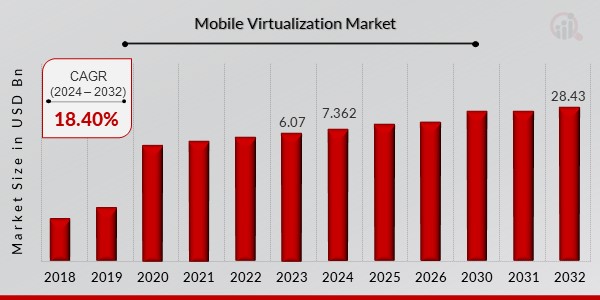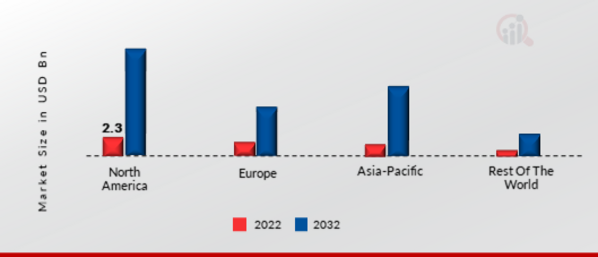Mobile Virtualization Market Overview
The Mobile Virtualization market size is projected to grow from USD 7.36291 billion in 2024 to USD 28.43 billion by 2032, exhibiting a compound annual growth rate (CAGR) of 18.40% during the forecast period (2024 - 2032). Additionally, the market size for Mobile Virtualization was valued at USD 6.07 billion in 2023.
Rising focus on technological advancements, increasing employees' productivity, growing digitization of economies and surge in the expenditure for R&D activities regarding security solutions are the key market drivers enhancing the market growth.
Figure1: Mobile Virtualization Market, 2018 - 2032 (USD Billion)

Source: Primary Research, Secondary Research, Market Research Future Database and Analyst Review
Mobile Virtualization Market Trends
Enhanced data security offered by mobile virtualization is driving the market growth.
Market CAGR for mobile virtualization is driven by the growing information security as it is one of the critical concerns among organizations, as most of the threats are now more potent. The industry is vulnerable to numerous attacks ranging from the infection of corporate networks by custom malware to targeted hacking, sophisticated phishing attacks, and outright tampering with intellectual property. However, mobile virtualization solutions, including app virtualization, have evolved as an ideal way to defend organizations better for securing their information and managing risk.
The centrally managed virtualized apps are generally delivered on demand as a service to any device that controls unauthorized access to its critical data and applications.
Additionally, increased digitization and automation in manufacturing have fueled Internet of Things deployments & connected devices and the need for mobile virtualization solutions. Many organizations leverage 5G capabilities with reduced latency to adopt highly automated deployments and management approaches. Besides, advances in virtualization techniques push the growth of the mobile virtualization market revenue. Also, the growing need for expanded telecom network capabilities surged the adoption of mobile virtualization on a large scale. Mobile operators are increasingly pressured to offer optimal networks for various business models through virtualization capability.
Enterprises have witnessed increased adoption of workspace-as-a-service in recent years and are expected to maintain this trend in the forthcoming years, owing to its numerous benefits, such as organizations' flexibility and reliability in various office places. In addition, organizations are adopting this technology, as it provides a virtual desktop, which enables users to access different office applications from anywhere around the world. This trend has led to a shift in preference for cloud-based "as a service" solutions over on-premise (servers or workstations) among organizations. Thus, increased adoption of WaaS among end users is expected to create significant future market opportunities.
A surge in smartphone adoption, data protection requirements, and cost savings due to mobile virtualization will contribute considerably to the growth of the mobile virtualization market over the forecast period. The emergence of workspace-as-a-service and increased adoption of cloud-based virtual desktop infrastructure (VDI) are advantages that can easily lead to sidelining such hindrances observed by the mobile virtualization market, such as performance and compatibility issues of mobile virtualization.
Mobile Virtualization Market Segment Insights
Mobile Virtualization Type Insights
The global mobile virtualization market segmentation, based on type, includes enterprise and consumer. The consumer segment dominated the market, accounting for 35% of market revenue (2.12 Billion). In developing economies, category growth is driven by its range of benefits to the end-users, such as isolating personal and work data, BYOD services in firms, etc. However, enterprise is the fastest-growing category as enterprises worldwide increasingly adopt mobile virtualization, offering improved IT efficiency and business continuity.
Mobile Virtualization Application Insights
The global mobile virtualization market segmentation, based on application, includes hypervisor, mobile device management, and application container. The hypervisor segment dominated the market, accounting for major market revenue. Hypervisors are meant to drive virtualization by enabling physical host machines to operate several virtual machines as guests, thus maximizing computing resources such as bandwidth, memory, CPU cycles, etc. However, application container is the fastest-growing category due to the increasing need for a high volume of data to maintain on cloud storage and on-demand content through an internet server.
Figure 2: Global Mobile Virtualization Market, by Application, 2022 & 2032 (USD Billion)

Source: Secondary Research, Primary Research, Market Research Future Database and Analyst Review
Mobile Virtualization Industry Insights
The global mobile virtualization market segmentation, based on industry, includes banking & insurance, healthcare, media & entertainment, retail, telecom, IT, and others. The IT category generated the most income (70.4%) owing to the high adoption of virtualized technologies among enterprises and the rise in the need for the BYOD approach. However, the healthcare sector is expected to grow at the highest rate over the forecast period, due to the adoption of cloud technology in this sector for increasing performance flexibility and scalability while reducing production costs.
Mobile Virtualization Regional Insights
By region, the study delivers market insights into North America, Europe, Asia-Pacific and the Rest of the World. The North American mobile virtualization market will dominate this market, owing to the growing use of modern technologies and the increasing number of digitization activities by various regional organizations. Moreover, the growing adoption of advanced technologies and surging number of small and medium-scale enterprises will boost market growth in this region. Further, the US mobile virtualization market held the largest market share, and the Canadian mobile virtualization market was the fastest-growing market in the North American region.
Further, the major countries studied in the market report are The US, Canada, German, France, the UK, Italy, Spain, China, Japan, India, Australia, South Korea, and Brazil.
Figure 3: GLOBAL MOBILE VIRTUALIZATION MARKET SHARE BY REGION 2022 (USD Billion)

Source: Primary Research, Secondary Research, Market Research Future Database and Analyst Review
Europe's mobile virtualization market accounts for the second-largest market share due to the rising adoption of virtualization technology and digitalization activities driving the market growth in this region. Further, the German mobile virtualization market held the largest market share, and the UK mobile virtualization market was the fastest-growing market in the European region.
The Asia-Pacific mobile virtualization market is expected to grow at the fastest CAGR from 2023 to 2032. This is due to the rising focus on technological advancements, increasing business flexibility, and improved service levels. Moreover, China’s mobile virtualization market held the largest market share, and the Indian mobile virtualization market was the fastest-growing market in the Asia-Pacific region.
Mobile Virtualization Key Market Players & Competitive Insights
Leading market players are investing heavily in research and development to expand their product lines, which will help the mobile virtualization market grow even more. Market participants are also undertaking numerous strategic activities to expand their global footprint, with important market developments including new product launches, contractual agreements, mergers and acquisitions, higher investments, and collaboration with other organizations. To expand and survive in a more competitive and rising market climate, the mobile virtualization industry must offer cost-effective items.
Manufacturing locally to minimize operational costs is one of the key business tactics manufacturers use in the global mobile virtualization industry to benefit clients and increase the market sector. Major players in the mobile virtualization market, including VMware, Inc (US), IBM Corporation (US), CA Technologies (US), Oracle Corporation (US), and others, are attempting to increase market demand by investing in research and development operations.
International Business Machines Corp (IBM) is a provider of information technology (IT) products and services. The company produces and sells system hardware and software and offers infrastructure, hosting, and consulting services. IBM's product portfolio includes analytics, artificial intelligence (AI), automation, blockchain, cloud computing, IT infrastructure, IT management, cybersecurity, and software development products. The company also offers cloud, networking, security, technology consulting, application, business resilience, and technology support services. It serves the automotive, banking and financial markets, electronics, energy and utilities, healthcare, insurance, life sciences, manufacturing, metals and mining, retail and consumer products, and telecommunication industries.
In July 2019, IBM closed a transaction in which it bought all the issued and outstanding shares of Red Hat. While each share was bought for $190, the total equity value amounted to nearly $34 billion. With its scale and depth, IBM's unmatched industry expertise and innovation can now be paired with the hybrid cloud technologies developed by Red Hat and will thus lead to the acceleration of innovation with the next-gen hybrid multi-cloud platform.
Microsoft Corp creates, licenses, and supports software products, services, and devices. The firm offers a comprehensive range of operating systems, cross-device productivity applications, software development tools, server applications, business solution applications, video games, desktop and server management tools, and training and certification services. It also manufactures, designs, and sells hardware products, including PCs, gaming and entertainment consoles, tablets, and other intelligent devices. The firm delivers a broad spectrum of services, such as cloud-based solutions, solution support, and consulting services. Microsoft markets, distributes, and sells offerings via original equipment manufacturers, resellers, distributors, online marketplaces, Microsoft stores, and other partner channels.
In October 2022, Microsoft and Meta collaborated to develop immersive experiences for the future of work and play. As declared during Meta Connect 2022, the collaboration allowed to bring Mesh for Microsoft Teams to Meta Quest devices. It will assist people to gather virtually where work happens on smartphones, laptops, and mixed-reality headsets. Mesh for Teams with Meta Quest 2 and Meta Quest Pro devices will allow people to connect and collaborate as if they are together in person.
Key Companies in the Mobile Virtualization market include
Mobile Virtualization Industry Developments
April 2023: V-Valley, a leading value-added distributor of products, services, and IT complex solutions, announced a partnership with storage virtualization and software-defined storage company StarWind Software, Inc. to make mobile enterprise virtualization easy. The strategic alliance will allow all V-Valley customers to access the catalog of products offered by Starwind, focused on the all-flash hyper-convergence.
Mobile Virtualization Market Segmentation
Mobile Virtualization Technology Outlook
Mobile Virtualization Application Outlook
Mobile Virtualization Industry Outlook
Mobile Virtualization Regional Outlook
| Attribute/Metric |
Details |
| Market Size 2023 |
USD 6.07 Billion |
| Market Size 2024 |
USD 7.36291 Billion |
| Market Size 2032 |
USD 28.43 Billion |
| Compound Annual Growth Rate (CAGR) |
18.40% (2024-2032) |
| Base Year |
2023 |
| Market Forecast Period |
2024-2032 |
| Historical Data |
2018- 2022 |
| Market Forecast Units |
Value (USD Billion) |
| Report Coverage |
Revenue Forecast, Growth Factors, Market Competitive Landscape, and Trends |
| Segments Covered |
Technology, Application, Industry, and Region |
| Geographies Covered |
North America, Europe, Asia Pacific, and the Rest of the World |
| Countries Covered |
The US, Canada, German, France, UK, Italy, Spain, China, Japan, India, Australia, South Korea, and Brazil |
| Key Companies Profiled |
VMware, Inc (US), CA Technologies (US), IBM Corporation (US), Oracle Corporation (US), Citrix Systems, Inc (US), Microsoft Corporation, BlackBerry Limited (Canada), Harman International Industries, Inc (US), AT&T Inc (US), Red Hat, Inc (US), Google LLC (US), and Amazon.com Inc (US) |
| Key Market Opportunities |
Rising focus on the technological advancements |
| Key Market Dynamics |
The surge in the incidences of cyber-attacks, fraudulent attacks and data theft |
Mobile Virtualization Market Highlights:
Frequently Asked Questions (FAQ):
The global mobile virtualization market size was valued at USD 6.07 Billion in 2023.
The global market is projected to grow at a CAGR of 18.40% during the forecast period, 2024-2032.
North America had the largest share of the global mobile virtualization market.
The key players in the market are IBM Corporation (US), Oracle Corporation (US), Citrix Systems, Inc (US), Microsoft Corporation, BlackBerry Limited (Canada), Harman International Industries, Inc (US), AT&T Inc (US), Red Hat, Inc (US), Google LLC (US), and Amazon.com Inc (US).
The consumer category dominated the market in 2022.
The hypervisor had the largest share of the global market.
IT had the largest share of the global market.
















